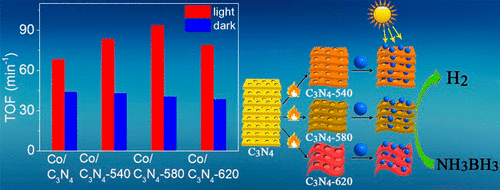当前位置:
X-MOL 学术
›
ACS Appl. Mater. Interfaces
›
论文详情
Our official English website, www.x-mol.net, welcomes your
feedback! (Note: you will need to create a separate account there.)
Non-Noble Metal Nanoparticles Supported by Postmodified Porous Organic Semiconductors: Highly Efficient Catalysts for Visible-Light-Driven On-Demand H2 Evolution from Ammonia Borane
ACS Applied Materials & Interfaces ( IF 8.3 ) Pub Date : 2017-09-18 00:00:00 , DOI: 10.1021/acsami.7b10280 Hao Zhang 1 , Xiaojun Gu 1 , Jin Song 1 , Na Fan 1 , Haiquan Su 1
ACS Applied Materials & Interfaces ( IF 8.3 ) Pub Date : 2017-09-18 00:00:00 , DOI: 10.1021/acsami.7b10280 Hao Zhang 1 , Xiaojun Gu 1 , Jin Song 1 , Na Fan 1 , Haiquan Su 1
Affiliation

|
From the viewpoint of controlling the visible-light-driven activities of catalysts containing metal nanoparticles (NPs) by tuning the microstructures of semiconducting supports, we employed a postsynthetic thermal modification approach to prepare carbon nitride (C3N4) species featuring different microstructures and then we synthesized Co and Ni NPs supported by these C3N4 species, which were used to catalyze the room-temperature H2 evolution from ammonia borane (NH3BH3). The systematic investigation showed that the catalysts had different activities under light irradiation. Compared with the pristine C3N4-based catalyst, all the modified C3N4-based catalysts had enhanced activities. The highest active Co catalyst with a total turnover frequency of 93.8 min–1 was successfully obtained, which exceeded the values of all the reported heterogeneous noble metal-free catalysts. The structure characterizations indicated that the postmodified porous C3N4 species had the different band structures, photoluminescence lifetime, and photocurrent density under visible light irradiation, leading to the different separation efficiency of photogenerated charge carriers. These characteristics helped us regulate the electronic characteristics of Co and Ni NPs in the supported catalysts and then led to the significantly different and enhanced activity in the visible-light-driven H2 evolution.
中文翻译:

后改性的多孔有机半导体支持的非贵金属纳米颗粒:高效的催化剂,用于氨硼烷可见光驱动的按需释放H 2
从通过调节半导体载体的微观结构来控制含金属纳米粒子(NPs)的催化剂的可见光驱动活性的观点出发,我们采用后合成热改性方法制备了具有不同微观结构和不同结构的氮化碳(C 3 N 4)物种。然后合成了由这些C 3 N 4物种支撑的Co和Ni NP ,它们被用来催化室温下H 2从氨硼烷(NH 3 BH 3)释放出来。系统研究表明,该催化剂在光照射下具有不同的活性。与原始C 3 N 4相比基催化剂,所有改性的C 3 N 4基催化剂均具有增强的活性。成功获得了最高活性的Co催化剂,其总周转频率为93.8 min –1,超过了所有已报道的非均相无贵金属催化剂的值。结构表征表明,后改性的多孔C 3 N 4在可见光照射下,这些物种具有不同的能带结构,光致发光寿命和光电流密度,从而导致光生载流子的分离效率不同。这些特性帮助我们调节了负载型催化剂中Co和Ni NPs的电子特性,然后导致了可见光驱动的H 2演化中显着不同和增强的活性。
更新日期:2017-09-19
中文翻译:

后改性的多孔有机半导体支持的非贵金属纳米颗粒:高效的催化剂,用于氨硼烷可见光驱动的按需释放H 2
从通过调节半导体载体的微观结构来控制含金属纳米粒子(NPs)的催化剂的可见光驱动活性的观点出发,我们采用后合成热改性方法制备了具有不同微观结构和不同结构的氮化碳(C 3 N 4)物种。然后合成了由这些C 3 N 4物种支撑的Co和Ni NP ,它们被用来催化室温下H 2从氨硼烷(NH 3 BH 3)释放出来。系统研究表明,该催化剂在光照射下具有不同的活性。与原始C 3 N 4相比基催化剂,所有改性的C 3 N 4基催化剂均具有增强的活性。成功获得了最高活性的Co催化剂,其总周转频率为93.8 min –1,超过了所有已报道的非均相无贵金属催化剂的值。结构表征表明,后改性的多孔C 3 N 4在可见光照射下,这些物种具有不同的能带结构,光致发光寿命和光电流密度,从而导致光生载流子的分离效率不同。这些特性帮助我们调节了负载型催化剂中Co和Ni NPs的电子特性,然后导致了可见光驱动的H 2演化中显着不同和增强的活性。











































 京公网安备 11010802027423号
京公网安备 11010802027423号